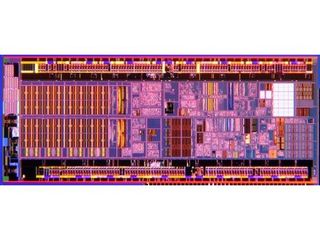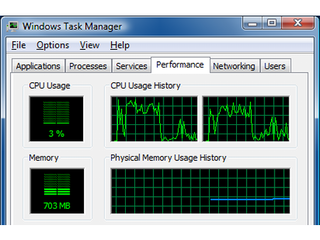Atom Benchmarked: 4W Of Performance
Overview Of Atom Technology
The range of mobile devices on the market is constantly increasing and has until now been dictated by ARM micro-architecture (RISC) - for example, the X-Scale processors that are found in PDAs or in the iPhone. Intel wants to use the Atom processor with x86 architecture to break into that same ARM market.

The Atom micro-architecture is completely different from that of the Core 2 or the AMD64. It was a completely new design by Intel, intended mainly keep power consumption and manufacturing costs very low — raw frequency plays a much less important role here.

The technology used in the Atom is known as “in order micro-architecture” and supports both 32 bit and 64 bit applications. The familiar speculative execution function has not been implemented here due to the high number of transistors this requires, and the corresponding increase in energy draw. Thus the architecture processes all commands one after another which means that the instructions per cycle (IPC) figure is not very high. The L1 cache is also set up differently; the Conroe micro-architecture has two 32 kB caches, whereas the Atom has a 32 kB instruction cache and a 24 kB write back cache.

The Atom processor only has one core, so Intel has reintroduced Hyper-Threading technology in order to ensure that it is used optimally, which means the processor has two logical processors. Thus, for some applications that are multi-core-capable, you can achieve better speeds using the single core. This also makes the operating system (such as Windows XP or Vista) considerably faster to react to commands.
The Atom micro-architecture covers almost all of the current command extensions: MMX, SSE, SSE2, SSE3 and SSSE3. Virtualization technology is also already available for some models.
Stay On the Cutting Edge: Get the Tom's Hardware Newsletter
Join the experts who read Tom's Hardware for the inside track on enthusiast PC tech news — and have for over 25 years. We'll send breaking news and in-depth reviews of CPUs, GPUs, AI, maker hardware and more straight to your inbox.
Current page: Overview Of Atom Technology
Prev Page Intel Atom 230 At 1.60 GHz With Hyper-Threading Next Page Functional Comparison Of The Atom-
jaragon13 Shouldn't it be on 9 - cooling and temperatures,be idle and load,instead of idle and idle? >.Reply -
When you look at the power consumption on load and compare it to the slowness of the chip while performing on load, it becomes clear why it only uses 4 watts more...Reply
-
A CPU without a platform is useless.Reply
Analyzing the Atom platform quickly from the power/performance perspective.
CPU name / idle W / load W/ Lame (seconds) / total Lame W used
Atom 230 / 40.5 W / 44.2 W / 773 s / 9.49 W
Celeron 220 / 44.9 W / 55.4 W / 375 s / 5.77 W
E2140 / 58.5 W / 69.5 W / 271 s / 5.23 W
Clearly the Atom platform is the most inefficient power/performance wise.
At idle you might win some W, but as soon as you try to do something you spend more power and waste more time.
There are other things you should consider, the frustration of having to wait for things that now we are used to do near instant and the inability to play HD video or use any significant graphics.
The only thing positive for atom is it's price. It's cheap. And maybe with a new chipset it might even be power efficient. But for now it's just cheap.
-
neiroatopelcc I wonder if it'd be able to play games if one were to equip it with a pci based 2400pro & 4gb of memory?Reply
Also, I wouldn't be surprised if someone invents a voltmod for those boards, so they can increase voltage for cpu, mch & ich enabling 2ghz+ speeds -
nachowarrior so in other words atom is pretty much a failure unless it's pumped into a tablet or umpc? and even then apparently isn't cost effective or readily available, nice...sounds like a great product launch.Reply -
I ran a google search for ECS 945GCT-D mainboard, and could not find it.Reply
I don't get it, why do you publish tests with products that don't even exist on the vendor web site?
Thank you, anyway -
Lans Raiden, while your numbers are true, I think a fairer comparison would be to use 773s for all processors (meaning the rest go to idle alot quicker). I suppose you can power your computer down afterwards or start up a web browser etc.Reply
Atom 230 (773s load / 0s idle) : 9.5W
Celeron 220 (375s load / 398s idle): 10.7W
E2140 (271s load / 502s idle): 13.4W
Sempron LE-1100 (43.9W idle, 70.4W load, 301s load / 472s idle): 11.6W
Sure this is biased against the Atom (not going idle at all) but with 4W delta between load and idle, I am too lazy to change the numbers already used.
I find it comparing the Atom to a Sempron LE-1100 more and Celeron 220 interesting:
"A Celeron at 1.20 GHz is 35% faster than an Atom at 1.60 GHz, but the Atom only consumes a fraction of the energy used by the Celeron. The AMD Sempron system, which uses almost the same energy in idle mode as the Atom system, is 43% faster."
-
haley0918 in anyway, despite of the low power and low performance, i still think it'll also be good as simple file server or home server besides as umpc. for experts, it'll be enough for some robotics and control application. just like the one used for Aiko in http://www.projectaiko.comReply
Most Popular



